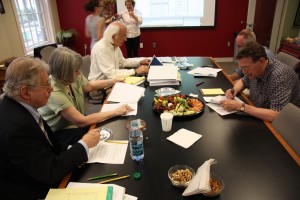
Six winners have been selected for the National Ideas Competition for the Washington Monument Grounds. Images of the refined idea concepts will be revealed in late September when the public will be called upon to vote for a People’s Choice award.
“We worked hard to get a diversity of approaches. We could not limit ourselves to five because the six winners were more demonstrative of the range of ideas,” explained jury chair Gregory Hunt, FAIA.
The Competition Stage 2 winners are:
Arcs of Shade by Stephen Lederach, Princeton, NJ – Formal, curvilinear design of trees completes the pedestrian experience of shaded walks from the Capitol through the Monument grounds to the Lincoln Memorial.
An Inclined Plane by Julian Hunt, Lucrecia Laudi, and Monling Lee, Washington, DC – The bold gesture of planes connects the great obelisk beyond the grounds to the larger Mall cross axis.
Field of Stars by Catherine Peek, Pittsburgh, PA – Poetic, ephemeral use of light gives human scale and nighttime interest to the site as well as the larger Mall landscape.
You and Me by Jinwoo Lim, Seoul, Korea – Highlights the centrality of the obelisk to the pedestrian experience of views to and from the Monument and of the historical significance of George Washington, the founding of the republic, and the central Mall axis.
The People’s Forum by Karolina Kawiaka, White River Junction, VT – An amphitheater supports the important civic role of the Mall to American democracy and emphasizes the centrality of the site to the Mall cross axis at the Jefferson Pier.
Monument of Unity by Jacques Prins, Kevin Battarbee and Egidijus Kasakaitis, Gouda, The Netherlands – A majestic skylit hall circling the obelisk’s foundation, accessible from cardinal directions, unifies the entrance experience and historical interpretation for all visitors.
In 2010, the organizers of the Competition asked interested individuals to think how they would complete the unfinished Monument grounds and make them more welcoming for broad civic engagement, hewing to issues of historic visions and modern sustainability, while enhancing the civic and educational experience that the Washington Monument presents for the next generation of visitors.
Hundreds responded from around the world and 24 semi-finalists were selected by the Stage 1 jury on Jan. 28, 2011. The Stage 2 panel of 5 distinguished jurors met on June 23, and reviewed the semi-finalists, debated, and selected the final 6 winners whose entries met in full measure the challenges set forth by the Competition founders. In the final stage of the competition in fall 2011 the public will be invited to select the “People’s Choice.”
“We carefully debated a range of notions from minimalist improvements to a major, large-scale reworking of the landscape,” said juror David Hackett Fisher, Pulitzer Prize-winning George Washington historian. “An organizing concept that emerged was that this unique site should serve as an agora, a common space that has many layers of meaning from the founding ideas of the republic to First Amendment activities, as well as practical needs for circulation, security, and flood control.”
Hunt, former dean of architecture at Catholic University, reflected on the differences jurors had about the major scope of some proposed changes and spoke of the inherent tension between doing a lot and doing very little. “We seriously considered the extremes expressed by the ideas between intrusiveness versus unobtrusiveness. In the end, we chose creative, exciting, and challenging ideas that will give the public real options to choose from and inspire people to think about the long-term possibilities.”
Former Washington Post architecture critic Benjamin Forgey came to the jury looking for simplicity and minimalist designs for the grounds to protect the mound’s open character. “Some of the entries proposed dramatic, poetic, sometimes spectacular changes that amazed but also worried me,” he said. “But that is the nature of an ideas competition. My hope is that the process will stimulate public awareness and discussion of the kinds of changes needed to improve these sacred spaces at the very center of the National Mall.”
For juror Joy Zinoman, Founding Artistic Director of Washington’s Studio Theatre, some of the best ideas found ways to “create welcoming gathering spaces to support modern public use and connect with the larger Washington community.”
Juror Eric Groft, ASLA, Principal of Oehme, van Sweden & Associates, was pleased with the number of the entries which succeeded in “bringing gestures large and small into a cohesive, unified idea.”
Virginia Society AIA President and Competition Chairman James P. Clark, AIA, on behalf of the entire Steering Committee, applauded the work of the jury and the serious engagement of so many individuals who worked hard to meet the challenging issues posed by the Competition, and the grounds themselves. “We expect the notable ideas submitted for this Competition will be the real legacy of this Competition. They will promote awareness, education and thoughtful development of the Monument grounds.”
For more information, www.wamocompetition.org.
